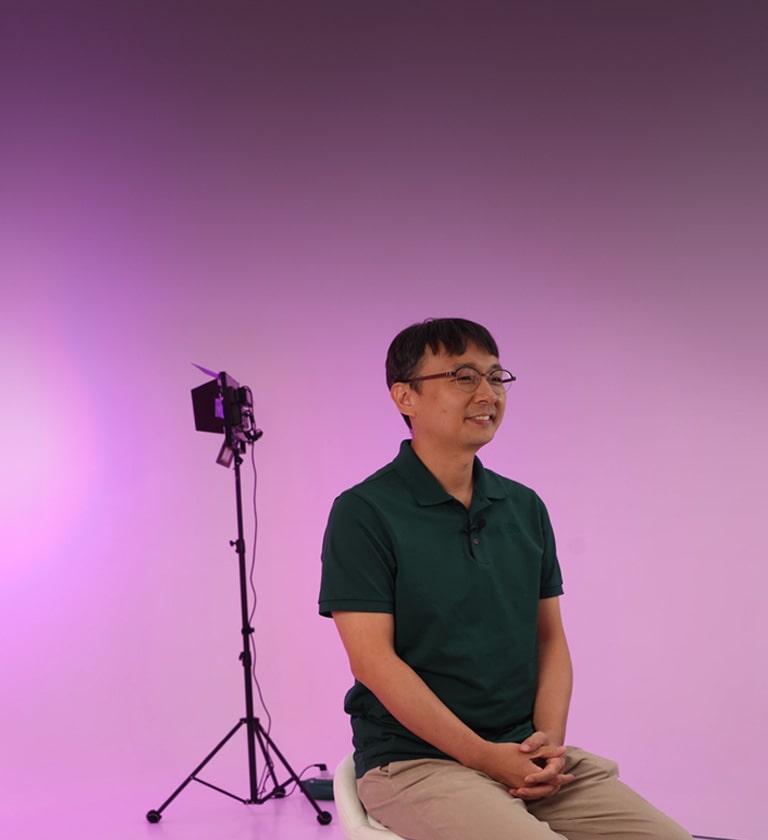-
In a fast-paced world, things are rapidly changing around us, be it the prices of commodities we consume or the machines we use. Air conditioners are no exception to this change. Ever since their invention, ACs have come a long way in terms of innovations and improvisation, however, they are still far from perfect. One of the most widespread issues in modern ACs have to be noise and vibration, contributing to noise pollution in residential areas.


-
Noise pollution is not only a huge disturbance but research shows that it induces stress, high blood pressure, hearing loss and other health problems.¹ Owing to this fact, customers these days are increasingly seeking ACs that produce little to no noise. We value our customers and prioritize their health, hence, we at LG Compressor and Motor have a CAE team dedicated to the task of eliminating noise and vibration issues in ACs and other home appliances.
-
Q. What is the CAE team and what does it do?
CAE is an abbreviation for Computer Aided Engineering. LG’s CAE team works to derive optimal noise and vibration results by identifying problems in advance and selecting countermeasures through simulation and actual experiments using analysis tools. It identifies problems that may occur when the compressor is installed on an outdoor unit of an air conditioner or dryer etc., and provides solutions accordingly.


-
Q. What is the most commonly used simulation method for noise issues in ACs?
The most commonly used simulation by the CAE team is Harmonic Acoustics. Every object has a unique vibrational characteristic or a natural frequency, similarly, every acoustic space has a unique acoustic natural frequency. Just as resonance avoidance design is essential in terms of vibration, acoustic natural frequency avoidance design is also required in terms of noise.
In this simulation method, the CAE team extracts the cavity of all paths in which the refrigerant moves from inside the compressor to the product and analyzes the acoustic properties and boundary conditions that vary from refrigerant to refrigerant, using a commercial program. The analysis results from the commercial program are demonstrated visually through post-processing easing the communication with clients.
-
Q. What are some alternative simulation methods?
In addition to the method mentioned above, there is another method of simulating piping stress and resonance band of the outdoor unit of an air conditioner. In this case, the team receives 3D modeling from their client in the product design stage and conducts a preliminary simulation to deduce estimated problems in advance and even suggest countermeasures.
Through simulation, countermeasures can be selected in advance for various noise and vibration problems that may occur in the future, so clients have the advantage of being capable of immediately responding to the issues that might occur in real life.
-
Q. Why is improving noise-related issues important in ACs?
Noise pollution has emerged as a major concern in Europe over the years. EEA (European Environment Agency) has indicated that noise pollution is the second largest environmental health threat in the EU, second to only air pollution.² Europe has rolled out laws and regulations to keep the noise emitted by HVAC/R units in check. In 2021, the UK implemented a new heat pump noise regulation announcing that heat pumps are only allowed to produce a maximum noise of 40 decibels at night.³
With the introduction of new laws and regulations, noise is gradually becoming a pivotal parameter dictating the quality and performance of HVAC products. The market standards are becoming stricter for products that are installed indoors, such as dryers, dehumidifiers, ACs, and AWHPs.
These days, many products are integrated with low-noise or sleep modes. This makes our surroundings even quieter, as a result, even low HZ noises become amplified. Noise, no matter how little it may be, can cause huge discomfort to light sleepers or users sensitive to noise. For the increased comfort of the end-user, it is necessary to alleviate noise-related issues in indoor HVAC products.


-
Q. What is the cause of noise in ACs?
Ever heard strange noises from your AC and wondered what’s the cause? More often than not, the culprit is the compressor inside the AC unit. The loudest part of any air conditioner is the compressor. In residential ACs, the most commonly used compressor is the rotary compressor. Rotary compressors are notorious for making noise when operated at low speed. This noise is a result of a structural drawback in rotary compressors and a solution is possible only through a fundamental change in the structure.
A rotary compressor requires a roller and a vane for compression. At low-speed operation the movement of the vane becomes unstable. Due to this unstable movement, the vane repeatedly loses and establishes contact with the roller causing abnormal noises. This is the source of noises in your ACs and other HVAC devices.
-
Q. How has LG overcome noise problems in rotary compressors?
Many HVAC manufacturers have tried to improve the noise from low-Hz operation in rotary compressors, but the structure of the rotary compressors makes it impossible to fundamentally address the problem.
In response to this shortcoming in current rotary compressors, LG has launched the LG Hinged-Vane Rotary Compressor. The LG Hinged-Vane Rotary Compressor uses a hinged vane structure with a combined vane and roller structure preventing collision between the two and ultimately stopping noises. The hinge structure improves both performance and noise/vibrations – the key issues in low-Hz operation.


-
As is visible in the illustration above, in conventional compressors, the vane and roller are separated, this causes repeated collision of the two and creates abnormal noises. However, in the LG Hinged-Vane Rotary Compressor (on the right), both are structurally merged, leaving no possibility of separation or collision. This structure has been tested to considerably reduce noises in a rotary compressor.
-
Q. What methods can be used to improve noises in ACs?
Replacing the current compressor with the LG Hinged-Vane Rotary Compressor is unarguably the most effective way to eliminate unnecessary noise and vibrations. However, in cases where it is not viable, LG experts propose alternative solutions to the problem.
When designing an air conditioner’s outdoor unit piping, it is necessary to apply one or more loops and give an appropriate R value per loop in terms of height and piping thickness. As the R value increases, the stress on the bending part decreases. Therefore, the design should be larger than a certain ratio compared to the pipe thickness to effectively absorb the vibration and stress generated during compressor startup/operation.
In the case of pipe re-excitation, find the nodal line of the band to be reduced and apply an optimized weight of the most appropriate type (isolator or butyl). The isolator has a mass increase effect and is highly effective in moving the resonance band. On the other hand, butyl is effective in reducing the response in the resonance band, so it is paramount to select the type depending on the purpose. It is equally important to choose the proper weight because unconditionally large and heavy things can cause side effects in other bands.
-
Conclusion
With the increasing severity of noise pollution, noise-curbing policies are expected to get more stringent. To keep abreast with the noise prevention policies, the HVAC industry will have to invest more time and effort in minimizing the noise from AC. With the rising demand for ACs, an increase in their quality and performance is expected.
-
1) https://www.epa.gov/clean-air-act-overview/clean-air-act-title-iv-noise-pollution
2)https://www.eumonitor.eu/9353000/1/j4nvhdfcs8bljza_j9vvik7m1c3gyxp/vm1jkl8ga9zm
3) https://www.adlar.co.uk/heat-pump-noise-explained/
Products In This Article
-
"The information contained in the article is released by LG Electronics and may not be used for personal work. It may not be copied, reproduced, modified, decompiled, or reverse-engineered into any other work without prior permission from LG Electronics."
-
*Products and solutions may vary according to country and operating conditions.
Please click the 'INQUIRY TO BUY' banner below to contact LG Sales Team for further information on solutions and products.





